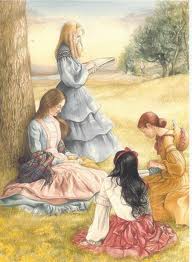
What’s it all about?:
In picturesque nineteenth-century New England, tomboyish Jo, beautiful Meg, fragile Beth, and romantic Amy come of age while their father is off to war.
What did I think?:
This is one of my all-time favourite childrens classics and our choice for March Kid-Lit, but as with a few of our previous Kid-Lit books I was slightly apprehensive about reading it as an adult, for fear I wouldn’t love it as much as I used to. I needn’t have feared however as it was just as terrific as I had remembered, although this time around I picked up many more references to religion than I remember being in the novel as a child. It tells the story of the March family which consists of four sisters: Meg, the oldest who is incredibly gentile and beautiful, Jo our tomboy who enjoys anything remotely unladylike and has aspirations to become a writer, Beth the angel in their midst who is kind, unselfish and vulnerable and the youngest Amy who loves anything connected with art and amuses her older sisters with her choice of vocabulary and grand ideas. The story is basically a coming of age novel in which four young girls become women, and the trials that come with becoming a “grown-up,” such as love, marriage, disappointment and tragedy.
This is not just another one of those classics that can become slightly tedious or where nothing much happens – there is plenty of drama for the March family, where there always seems to be something afoot and is in my opinion, a truly heart-warming read. As the girls grow up we hear of their exuberance in putting on small plays, share in the tension as Amy burns Jo’s precious manuscript and worry with them when Beth comes down with scarlet fever. One thing that did surprise me when re-reading this book as an adult as I mentioned previously was how much of a factor religion played in the novel which I didn’t remember having been there previously. Marmee in particular seems to be the dominating persona for this within the household and consistently teaches her girls about the way of the world if they follow God. I don’t mind religion in novels and in certain cases where the religion isn’t Christian interests me greatly and makes me more likely to read a book, but I tend to get slightly exasperated if it becomes too “preachy.” Luckily, I don’t think it comes across that way in Alcott’s novel and is more a background reminder for the children to live their lives by, and to encourage them to be good and honest individuals.
I have the Little Women complete series on my Kindle and I have to admit I was slightly confused after finishing Little Women (at the point where Meg agrees to marry John) and seeing THE END, as I remembered a lot more happening after this event. After a short spot of googling however I found out that the second instalment in the series, Good Wives was originally published separately but both books together made up the story of Little Women. I love the classic storybook happy ending also which paves the way for the next novel Little Men: Life at Plumfield with Jo’s Boys which I’m quite certain I haven’t read before but will be certain to (Kid-Lit 2015, sis?!)
Reading this book again was an absolute pleasure, the characters are wonderful and so loveable and it reminded me why it is considered a classic work of fiction in the first place. Best bit? It’s pretty hard to choose, some of the scenes will always be highly memorable for me but I have to mention the scene where Aunt March’s parrot looks under a piece of furniture after a spider he has chased there and invites it to: “Come and take a walk my dear?.” Hilarious and utterly brilliant! Definitely one of my favourite pieces of Kid-Lit and I hope future generations will continue to treasure it.
For Chrissi’s fabulous review please see her post HERE
Would I recommend it?:
But of course!
Star rating (out of 5):











